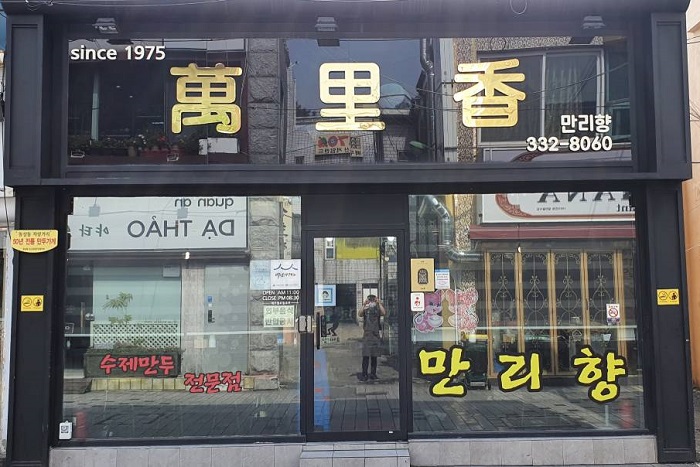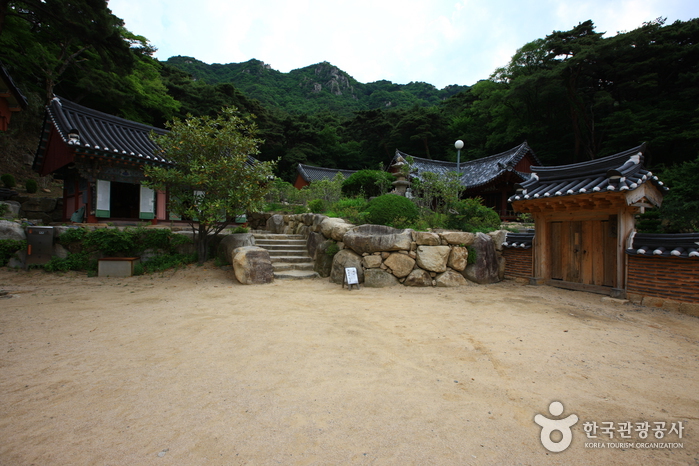Mallihyang (만리향)
2.2 Km 173 2021-03-20
4, Bunseong-ro, 335beon-gil, Gimhae-si, Gyeongsangnam-do
+82-55-332-8060
A store featured in famous Korean gourmet programs with 45 years’ tradition. This restaurant's signature menu is steamed dumpling. This Korean dishes restaurant is located in Gimhae-si, Gyeongsangnam-do.
Mh Modern House - Homeplus Gimhae Branch [Tax Refund Shop] (MH 모던하우스 홈플러스김해)
2.3 Km 0 2024-04-23
2078, Gimhae-daero, Gimhae-si, Gyeongsangnam-do
-
Homeplus - Gimhae Branch [Tax Refund Shop] (홈플러스 김해)
2.3 Km 0 2024-04-18
2078, Gimhae-daero, Gimhae-si, Gyeongsangnam-do
-
Olive Young - Homeplus Gimhae Branch [Tax Refund Shop] (올리브영 홈플러스김해점)
2.3 Km 0 2024-06-27
2F, 2078, Gimhae-daero, Gimhae-si, Gyeongsangnam-do
-
Gimhae Eunhasa Temple (은하사(김해))
2.3 Km 14493 2021-02-24
167, Sineosan-gil, Gimhae-si, Gyeongsangnam-do
+82-55-337-0101
Eunhasa Temple is located in Sineosan Mountain in Gimhae, Gyeongsangnam-do. The year it was founded remains unknown, but legend has it that Monk Jangyuhwasang built the temple in AD 1, before the nationwide spread of Buddhism. However, relic pieces found at the temple site indicate the possibility of the temple's establishment in the Three Kingdoms Era. The temple was once burned down together with Dongnimsa Temple during the Imjin War and the architectural design seen today is that of the late Joseon dynasty.
Olive Young - Gimhae Samgye Branch [Tax Refund Shop] (올리브영 김해삼계)
2.3 Km 0 2024-04-22
47, Samgyejungang-ro, Gimhae-si, Gyeongsangnam-do
-
Gimhae Arts and Sports Center (김해문화의전당)
2.3 Km 14807 2022-12-29
2060, Gimhae-daero, Gimhae-si, Gyeongsangnam-do
+82-55-320-1234
The Gimhae Arts and Sports Center is a performance hall for high-class performances. Maru Hall is a multi-purpose theater that also contains a moving orchestra shell with a sound reflection board for a smaller concert hall inside the theater. Nuri Hall is an experimental theater for performances in a variety of themes. The center also features the outdoor theater Aedureum Madang, Yunseul Art Gallery, Media Center, Sports Center, and Aram Learning Center, as well as a café and restaurants.
Ancient Tombs in Daeseong-dong, Gimhae (김해 대성동 고분군)
2.4 Km 8390 2020-04-02
126, Gayaui-gil, Gimhae-si, Gyeongsangnam-do
+82-55-330-3934
The tumuli in Daeseong-dong, located to the east of the Royal Tomb of Kim Suro, reflect the formation and development of the Gaya Era. The Daeseong-dong Tumuli are located in the center of the shell mounds of Hoehyeon-ri, the location of the founding of the Gaya Kingdom according to local legend.
The tumuli relics were excavated by researchers from the Kyungsung University Museum from 1990 to 1992 and were found to be the common burial ground of the dominant class of the Gaya Kingdom. On the hilltops, which were viewed as prime burial places, are the tombs of kings and rulers; on the slopes are the tombs of the lower classes.
A total of 136 tumuli were found in the Daesong-dong area. Further investigation of the tumuli revealed several important and interesting facts. First, from the end of the third century, men and horses were buried alive along with the dead. Also, weapons were bent and buried as well, with many of these artifacts being unearthed among the tumuli. Other materials found in the tumuli such as cylindrical bronze items, pinwheel-shaped bronze items, and jasper items showed that Gaya was involved in trade with Japan. The Daeseong-dong Tumuli is significant in that it gives a glimpse into the political and social structure of the Gaya Kingdom, and the cultural exchange between Korea, China, and Japan.
Tomb of King Suro (수로왕릉)
2.4 Km 16800 2024-01-23
26 Garak-ro 93beon-gil, Gimhae-si, Gyeongsangnam-do
+82-55-332-1094
King Suro founded the Garak Kingdom in AD 42 and married Heo Hwang-ok, a princess from the Indian country of Ayuta, in AD 48. He was the founder of the Gimhae Kim family. Heo Yeop, a Yeongnam governor, gave the tomb its current look in the 13th year of the reign of King Seonjo (1580). The tomb compound includes various buildings, including the Sungseonjeon (where the ancestral tablets of King Suro and his queen are kept), Anhyanggak, Jeonsacheong, and Jegigo, as well as stone structures, such as a sindobi (tombstone) and gongjeokbi (monument established to pay homage the deceased). The tombstone in front of the royal tomb was built in the 25th year of the reign of King Injo (1647) of the Joseon dynasty. The name Sungseonjeon was bestowed on the tomb by King Gojong in the 21st year of his reign (1884).
Sureungwon Garden (수릉원)
2.4 Km 8301 2024-01-23
35 Bunseong-ro 261beon-gil, Gimhae-si, Gyeongsangnam-do
Sureungwon Garden is a place themed around the meeting between King Suro, the founder of Gaya, and Queen Heo, who was the princess of Ayuta Kingdom, known as India. The name Sureungwon Garden also contains the meaning of an elegant forest where King Suro and Queen Heo walked together. An ecological park measuring 39,600 m2 has been created along a low ridge that connects the Tomb of King Suro, an important cultural heritage of the Gaya period; the Ancient Tombs in Daeseong-dong, the tombs of the Gaya kings; and the Bonghwang-dong Historic Site. It was created by representing the maritime kingdom of Gaya, imagining a pond of the garden where King Suro and Queen Heo used to walk, and planting prickly waterlilies and yellow floating hearts that are believed to have inhabited wetlands in the Gaya period. Trails along the cozy forest and pond make it easy to look around comfortably.

![Mh Modern House - Homeplus Gimhae Branch [Tax Refund Shop] (MH 모던하우스 홈플러스김해)](http://tong.visitkorea.or.kr/cms/resource/56/2885956_image2_1.jpg)
![Homeplus - Gimhae Branch [Tax Refund Shop] (홈플러스 김해)](http://tong.visitkorea.or.kr/cms/resource/59/2885959_image2_1.jpg)


![Olive Young - Gimhae Samgye Branch [Tax Refund Shop] (올리브영 김해삼계)](http://tong.visitkorea.or.kr/cms/resource/28/2885928_image2_1.jpg)
 English
English
 한국어
한국어 日本語
日本語 中文(简体)
中文(简体) Deutsch
Deutsch Français
Français Español
Español Русский
Русский